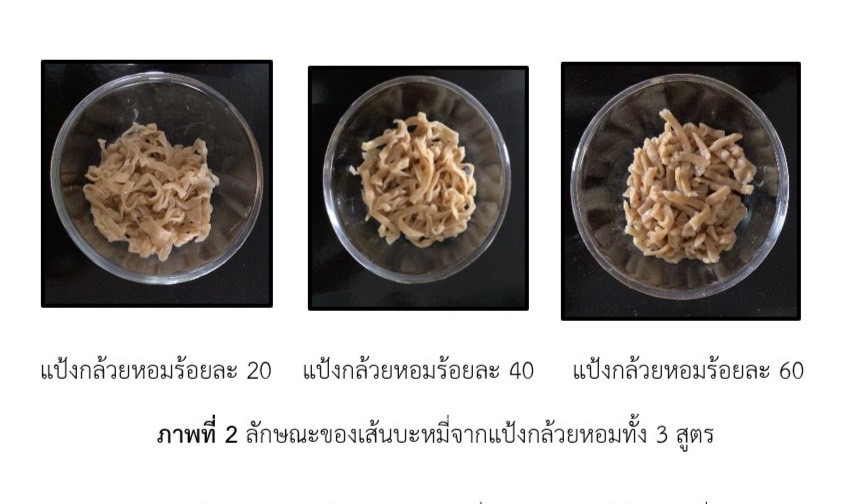Product Development of Banana Flour Substituted Noodles
Main Article Content
Abstract
The objectives of this research were 1) to study the type of banana flour suitable for making noodles from banana flour; 2) to study the appropriate amount of banana flour to substitute wheat flour in noodles products; and 3) to determine the acceptance of consumer to noodle products made with banana flour. The experimental design was a randomized complete block design (RCBD). The sensory evaluation results were shown 9-level scores pattern (9-point hedonic scale). The study of suitable banana flour type for noodle development from Kluai Nam Wa and Kluai Hom flour indicated that the Kluai Hom flour substituted noodles were accepted by panelists (p<0.05) with the highest scores. Therefore, the use Kluai Hom flour was chosen to prepare noodles and wheat flour was replaced by 20, 40, and 60% of banana flour. The result showed that noodle containing 40% of banana flour were the most accepted. It due to banana flour contains high-fiber starch, resulting in noodle becomes harder and tougher textures and cannot be substituted for higher amount. The acceptability evaluation results of 50 consumers found that 94% of consumers accepted the banana flour-substituted noodles due to the product is new with the nutritious from banana flour. In addition, consumers are also interested in purchasing the banana flour-substituted noodles when they are available in health food stores because these products considered as the products that meet the needs of health-conscious people.
Article Details
References
ไกรสิทธิ์ ตันติศิรินทร์. (2559). ไขข้อข้องใจด้านอาหารและโภชนาการ. Sanook.com. https://www.sanook.com/women/60339/
จารุวรรณ บางแวก, อรวรรณ จิตต์ธรรม, จารุรัตน์ พุ่มประเสริฐ และฐิติภัทร มีบุบผา. (2553). การประเมินคุณสมบัติของแป้งจากพืช. การประชุมวิชาการวิทยาการหลังการเก็บเกี่ยวแห่งชาติครั้งที่ 9, 520-534. จัดโดย ศูนย์นวัตกรรมเทคโนโลยีหลังการเก็บเกี่ยว ร่วมกับมหาวิทยาลัยเทคโนโลยีพระจอมเกล้าธนบุรี ณ โรงแรมพัทยาพาร์คบีช รีสอร์ท ชลบุรี.
จิรนาถ บุญคง, ทิพวรรณ บุญมี และพัชราวรรณ เรือนแก้ว. (2558). การใช้แป้งกล้วยหอมทองดิบที่มีสมบัติต้านทานการย่อยด้วยเอนไซม์ในผลิตภัณฑ์เส้นพาสต้า. วารสารเทคโนโลยีการอาหาร มหาวิทยาลัยสยาม, 10(1). 19-29.
จุฑามาศ พีรพัชระ. (2554). โครงการการเพิ่มมูลค่าผลิตภัณฑ์แปรรูปจากกล้วยเพื่อใช้ประโยชน์เชิงพาณิชย์ (รายงานผลการวิจัย). มหาวิทยาลัยเทคโนโลยีราชมงคลพระนคร.
วลัย หุตโกวิท และดวงแข สุขโข. (2558). “แป้งกล้วย”. กล้วยครบวงจร ผลงานวิจัยเพื่อสนองพระราชดำริโครงการอนุรักษ์พันธุกรรมพืช. www.chutamas.info/?p=1212.
สุมิตรา จันทร์เงา. (2561). ผงกล้วยน้ำว้า รักษาโรคกระเพาะอาหาร. technologychaoban.com. https://www.technologychaoban.com/thai-local-wisdom/article_87469?fbclid
Murray, M. T. (1996). Encyclopedia of Nutritional Supplements: the Eessential Guidefor improving You Health Naturally: Prima Pub.
Oh, N. H., Seib, P . A., Deyoe, C. W., & Ward, A. B. (1983). Noodles. I. Measuring the textural characteristics of cooked noodles. Cereal Chemistry, 60(6), 433-438.


